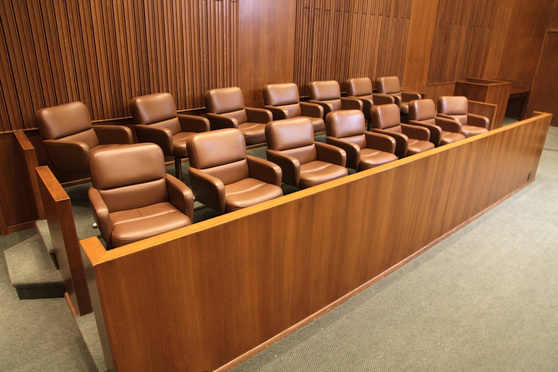Judge's Absence During Voir Dire Leads to New Med Mal Trial
University of Pittsburgh Medical Center's victory in a medical malpractice lawsuit was short-lived as an appeals court ordered a new trial after finding that the jury selection process was tainted.
May 17, 2018 at 12:09 AM
4 minute read

University of Pittsburgh Medical Center's victory in a medical malpractice lawsuit was short-lived as an appeals court ordered a new trial after finding that the jury selection process was tainted.
A three-judge Superior Court panel consisting of Judges Mary Jane Bowes, Judith Olson and Deborah A. Kunselman granted Mendy Trigg's appeal of an Allegheny County jury's verdict in favor of UPMC in which she argued that the selected jurors were biased.
The issue centered on the absence of the Allegheny County judge during voir dire, and a lack of any firsthand observation of the jurors' demeanor during that process.
Trigg argued that the lack of judicial supervision allowed biased jurors to slip through the cracks, while the hospital maintained that the issue was a “red herring.”
“The knowledge gleaned from in-person observations is 'impossible to place in the record, [but] must be considered,'” Kunselman wrote in the court's opinion. “An absentee judge misses the crucial instant when would-be jurors reveal their inmost selves by both words and actions.”
UPMC pointed to a rule of civil procedure stating that clerks can act as stand-ins for judges during the jury selection process. The Superior Court disagreed with the application of that rule in Trigg's case.
“By not contemporaneously observing the jurors' responses, when ruling on challenges for cause, the trial judge in this case deprived himself of any greater perception of the jurors' partiality than an appellate court can discern by reviewing the same, cold record,” Kunselman said.
Kunselman illustrated the point by referencing a response from one juror who had a bias toward health care professionals because her family members are doctors, and said that she would probably find in favor of a doctor or hospital if the case was a “close call.”
Juror 29 continued, “I see what they go through and I know how much they care about their patients and I know they would never do anything wrong.”
Kunselman noted, “This answer shows her implicit trust for medical professionals. Juror 29 clearly viewed the patient/doctor relationship through the rose-colored glasses of familial love and admiration, and assumed the medical professionals sued in this case would do no harm.”
In a concurring statement from Bowes, the judge said she agreed with the majority ruling and further urged Allegheny County to re-evaluate its jury selection procedures.
“The judge makes the decision whether to disqualify a potential juror based upon a review of transcribed answers to voir dire questions, or in some cases, after a subsequent interview with the challenged individual,” Bowes said. “For the reasons cited by the majority, I agree that such a procedure warrants a departure from the deference usually afforded to the rulings of judges who contemporaneously observe or participate in the voir dire process.”
Douglas Price of Harry S. Cohen & Associates represents Trigg and Jason Zivkovic of Dickey, McCamey & Chilcote represents the hospital.
In an email, Zivkovic said, “We respectfully vehemently disagree with the Superior Court's decision because their eagerness to change the voir dire process by this route is misguided and they did not consider all of the testimony of Juror 29 demonstrating the juror's ability to be fair and impartial. There were no contentions that any of the jurors who actually heard the case were unfair and biased; therefore, plaintiff did not suffer any prejudice. We plan to ask the en banc Superior Court to review it and then file a petition for allocatur to the Supreme Court, if necessary.”
Price did not respond to a request for comment.
This content has been archived. It is available through our partners, LexisNexis® and Bloomberg Law.
To view this content, please continue to their sites.
Not a Lexis Subscriber?
Subscribe Now
Not a Bloomberg Law Subscriber?
Subscribe Now
NOT FOR REPRINT
© 2025 ALM Global, LLC, All Rights Reserved. Request academic re-use from www.copyright.com. All other uses, submit a request to [email protected]. For more information visit Asset & Logo Licensing.
You Might Like
View All
No Pa. Case Has Ever Adjudicated a Claim to Enforce an Environmental Covenant Imposed Under 'Act 2'—Does That Matter?
7 minute read
Superior Court Rejects Pa. Hospital's Challenge to $7.3M Med Mal Judgment
3 minute read
Pittsburgh Judge Rules Loan Company's Online Arbitration Agreement Unenforceable
3 minute read
De-Mystifying the Ethics of the Attorney Transition Process, Part 1
Trending Stories
Who Got The Work
Michael G. Bongiorno, Andrew Scott Dulberg and Elizabeth E. Driscoll from Wilmer Cutler Pickering Hale and Dorr have stepped in to represent Symbotic Inc., an A.I.-enabled technology platform that focuses on increasing supply chain efficiency, and other defendants in a pending shareholder derivative lawsuit. The case, filed Oct. 2 in Massachusetts District Court by the Brown Law Firm on behalf of Stephen Austen, accuses certain officers and directors of misleading investors in regard to Symbotic's potential for margin growth by failing to disclose that the company was not equipped to timely deploy its systems or manage expenses through project delays. The case, assigned to U.S. District Judge Nathaniel M. Gorton, is 1:24-cv-12522, Austen v. Cohen et al.
Who Got The Work
Edmund Polubinski and Marie Killmond of Davis Polk & Wardwell have entered appearances for data platform software development company MongoDB and other defendants in a pending shareholder derivative lawsuit. The action, filed Oct. 7 in New York Southern District Court by the Brown Law Firm, accuses the company's directors and/or officers of falsely expressing confidence in the company’s restructuring of its sales incentive plan and downplaying the severity of decreases in its upfront commitments. The case is 1:24-cv-07594, Roy v. Ittycheria et al.
Who Got The Work
Amy O. Bruchs and Kurt F. Ellison of Michael Best & Friedrich have entered appearances for Epic Systems Corp. in a pending employment discrimination lawsuit. The suit was filed Sept. 7 in Wisconsin Western District Court by Levine Eisberner LLC and Siri & Glimstad on behalf of a project manager who claims that he was wrongfully terminated after applying for a religious exemption to the defendant's COVID-19 vaccine mandate. The case, assigned to U.S. Magistrate Judge Anita Marie Boor, is 3:24-cv-00630, Secker, Nathan v. Epic Systems Corporation.
Who Got The Work
David X. Sullivan, Thomas J. Finn and Gregory A. Hall from McCarter & English have entered appearances for Sunrun Installation Services in a pending civil rights lawsuit. The complaint was filed Sept. 4 in Connecticut District Court by attorney Robert M. Berke on behalf of former employee George Edward Steins, who was arrested and charged with employing an unregistered home improvement salesperson. The complaint alleges that had Sunrun informed the Connecticut Department of Consumer Protection that the plaintiff's employment had ended in 2017 and that he no longer held Sunrun's home improvement contractor license, he would not have been hit with charges, which were dismissed in May 2024. The case, assigned to U.S. District Judge Jeffrey A. Meyer, is 3:24-cv-01423, Steins v. Sunrun, Inc. et al.
Who Got The Work
Greenberg Traurig shareholder Joshua L. Raskin has entered an appearance for boohoo.com UK Ltd. in a pending patent infringement lawsuit. The suit, filed Sept. 3 in Texas Eastern District Court by Rozier Hardt McDonough on behalf of Alto Dynamics, asserts five patents related to an online shopping platform. The case, assigned to U.S. District Judge Rodney Gilstrap, is 2:24-cv-00719, Alto Dynamics, LLC v. boohoo.com UK Limited.
Featured Firms
Law Offices of Gary Martin Hays & Associates, P.C.
(470) 294-1674
Law Offices of Mark E. Salomone
(857) 444-6468
Smith & Hassler
(713) 739-1250





